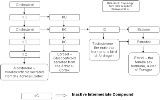
Steroid hormone
Overview
A steroid hormone
is a steroid
that acts as a hormone
. Steroid hormones can be grouped into five groups by the receptor
s to which they bind: glucocorticoid
s, mineralocorticoid
s, androgen
s, estrogen
s, and progestogens. Vitamin D
derivatives are a sixth closely related hormone system with homologous receptors, though technically sterol
s rather than steroids.
Steroid hormones help control metabolism, inflammation, immune functions, salt and water balance, development of sexual characteristics, and the ability to withstand illness and injury.
The term steroid both describes hormones produced by the body and artificially produced medications that duplicate the action for the naturally occurring steroids.
The natural steroid hormones are generally synthesized from cholesterol
in the gonad
s and adrenal gland
s.
is a steroid
Steroid
A steroid is a type of organic compound that contains a characteristic arrangement of four cycloalkane rings that are joined to each other. Examples of steroids include the dietary fat cholesterol, the sex hormones estradiol and testosterone, and the anti-inflammatory drug dexamethasone.The core...
that acts as a hormone
Hormone
A hormone is a chemical released by a cell or a gland in one part of the body that sends out messages that affect cells in other parts of the organism. Only a small amount of hormone is required to alter cell metabolism. In essence, it is a chemical messenger that transports a signal from one...
. Steroid hormones can be grouped into five groups by the receptor
Receptor (biochemistry)
In biochemistry, a receptor is a molecule found on the surface of a cell, which receives specific chemical signals from neighbouring cells or the wider environment within an organism...
s to which they bind: glucocorticoid
Glucocorticoid
Glucocorticoids are a class of steroid hormones that bind to the glucocorticoid receptor , which is present in almost every vertebrate animal cell...
s, mineralocorticoid
Mineralocorticoid
Mineralocorticoids are a class of steroid hormones characterised by their similarity to aldosterone and their influence on salt and water balances.-Physiology:...
s, androgen
Androgen
Androgen, also called androgenic hormone or testoid, is the generic term for any natural or synthetic compound, usually a steroid hormone, that stimulates or controls the development and maintenance of male characteristics in vertebrates by binding to androgen receptors...
s, estrogen
Estrogen
Estrogens , oestrogens , or œstrogens, are a group of compounds named for their importance in the estrous cycle of humans and other animals. They are the primary female sex hormones. Natural estrogens are steroid hormones, while some synthetic ones are non-steroidal...
s, and progestogens. Vitamin D
Vitamin D
Vitamin D is a group of fat-soluble secosteroids. In humans, vitamin D is unique both because it functions as a prohormone and because the body can synthesize it when sun exposure is adequate ....
derivatives are a sixth closely related hormone system with homologous receptors, though technically sterol
Sterol
Sterols, also known as steroid alcohols, are a subgroup of the steroids and an important class of organic molecules. They occur naturally in plants, animals, and fungi, with the most familiar type of animal sterol being cholesterol...
s rather than steroids.
Steroid hormones help control metabolism, inflammation, immune functions, salt and water balance, development of sexual characteristics, and the ability to withstand illness and injury.
The term steroid both describes hormones produced by the body and artificially produced medications that duplicate the action for the naturally occurring steroids.
The natural steroid hormones are generally synthesized from cholesterol
Cholesterol
Cholesterol is a complex isoprenoid. Specifically, it is a waxy steroid of fat that is produced in the liver or intestines. It is used to produce hormones and cell membranes and is transported in the blood plasma of all mammals. It is an essential structural component of mammalian cell membranes...
in the gonad
Gonad
The gonad is the organ that makes gametes. The gonads in males are the testes and the gonads in females are the ovaries. The product, gametes, are haploid germ cells. For example, spermatozoon and egg cells are gametes...
s and adrenal gland
Adrenal gland
In mammals, the adrenal glands are endocrine glands that sit atop the kidneys; in humans, the right suprarenal gland is triangular shaped, while the left suprarenal gland is semilunar shaped...
s.
Unanswered Questions
Discussions

